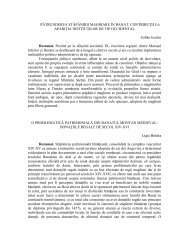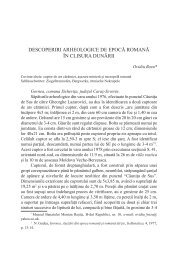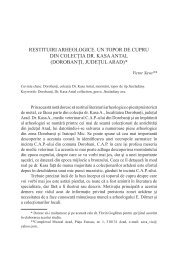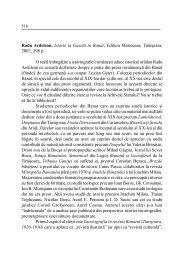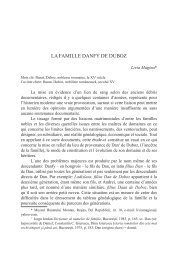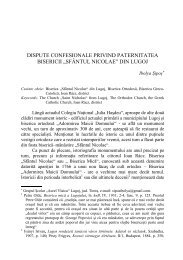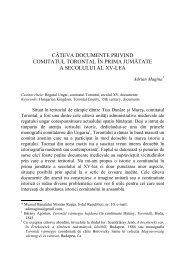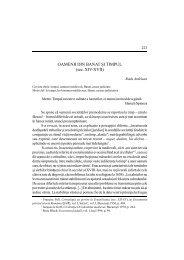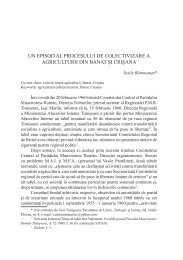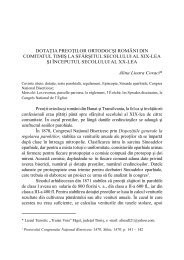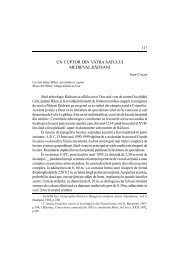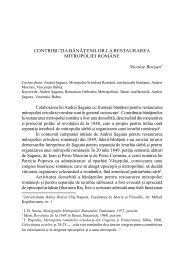jOHN HUNYADI BETwEEN BELGRADE AND CETATEA ... - Banatica
jOHN HUNYADI BETwEEN BELGRADE AND CETATEA ... - Banatica
jOHN HUNYADI BETwEEN BELGRADE AND CETATEA ... - Banatica
Create successful ePaper yourself
Turn your PDF publications into a flip-book with our unique Google optimized e-Paper software.
58<br />
Except for the mid 1460’, Stephen III of Moldavia preserved until the<br />
mid 1470’ a predominantly pro-Ottoman and anti-Genoese political course 82 .<br />
The son of the most loyal to john Hunyadi of the all rulers (due to necessities),<br />
Stephen III proved to be the most disloyal of all ‘Hunyadi creatures’. Yet<br />
Stephen was only in (small or medium) part a real ‘creature’. Even if enraged<br />
by the outcome of his Moldavian campaign of 1467, king Matthias had to<br />
(indirectly) accept that in his letter to the Polish elite, while claiming that john<br />
Hunyadi had done as it had pleased him in walachia and Moldavia (1468) 83 .<br />
Eventually, it was still easier for Thuróczy or Bonfini to portrait Hunyadi’s<br />
successes.<br />
whether already prior to Alexander II’s acceptance as ruler by john<br />
Hunyadi or only after the fall of Elias I’ son, Stephen III, the ‘most illegitimate’<br />
of all Moldavian rulers until then, spent probably time in Transylvania (here he<br />
john learnt Hungarian, if he did not know it from the Lower Country, and also<br />
probably accepted Church Union as a Hunyadi contender). If Stephen fled to<br />
Transylvania (and not to walachia), immediately after Bogdan II’s execution<br />
by Peter III Aron and his followers (October 1451), he, like Vlad III (due to the<br />
provisions the Ottoman-Hungarian ‘peace’ of November 1451), was probably<br />
expelled from Transylvania, following Alexander II’s acceptance as ruler by<br />
Hunyadi in winter 1452-1453. It is possible that he returned to Transylvania<br />
from walachia (still, a chronicle, deemed unreliable, apparently places him in<br />
the Ottoman Empire in the early 1450’ 84 ).<br />
At any rate, until his enthronement, Stephen III moves seemed to<br />
have been often linked to those of Vlad III the Impaler. In summer 1456,<br />
while (already) in walachia, Stephen met with Moldavian chancellor, Mihul<br />
(on krakow’s pay roll until his death in the late 1480’, on his way to sultan<br />
Mehmed II with Moldavia’s tribute 85 . Stephen III and Mihul attempted a<br />
82 Al. Simon, The Arms of the Cross: The Christian Policies of Stephen the Great and Matthias<br />
Corvinus, in Between Worlds, I, p. 77-79.<br />
83 Vilmos Fraknói, Mátyás király levelei. Külügyi Osztály, I, 1458-1479, Budapest 1893, no.<br />
149, p. 211-212.<br />
84 See Ştefan cel Mare şi Sfânt în contextul epocii sale şi al posterităţii, Chişinău, 2004,<br />
(general-editor Demir Dragnev), p. 141, note 52 (the data comes from chronicle, preserved<br />
only in a version/ copy from the 1700’).<br />
85 For a thorough analysis, see Bogdan-Petru Maleon’s study Stephen the Great and John<br />
Hunyadi, in Between Worlds, II, p. 381-387.



